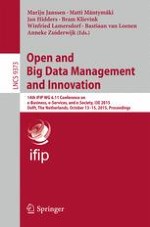2015 | Buch
Open and Big Data Management and Innovation
14th IFIP WG 6.11 Conference on e-Business, e-Services, and e-Society, I3E 2015, Delft, The Netherlands, October 13-15, 2015, Proceedings
herausgegeben von: Marijn Janssen, Matti Mäntymäki, Jan Hidders, Bram Klievink, Winfried Lamersdorf, Bastiaan van Loenen, Anneke Zuiderwijk
Verlag: Springer International Publishing
Buchreihe : Lecture Notes in Computer Science
